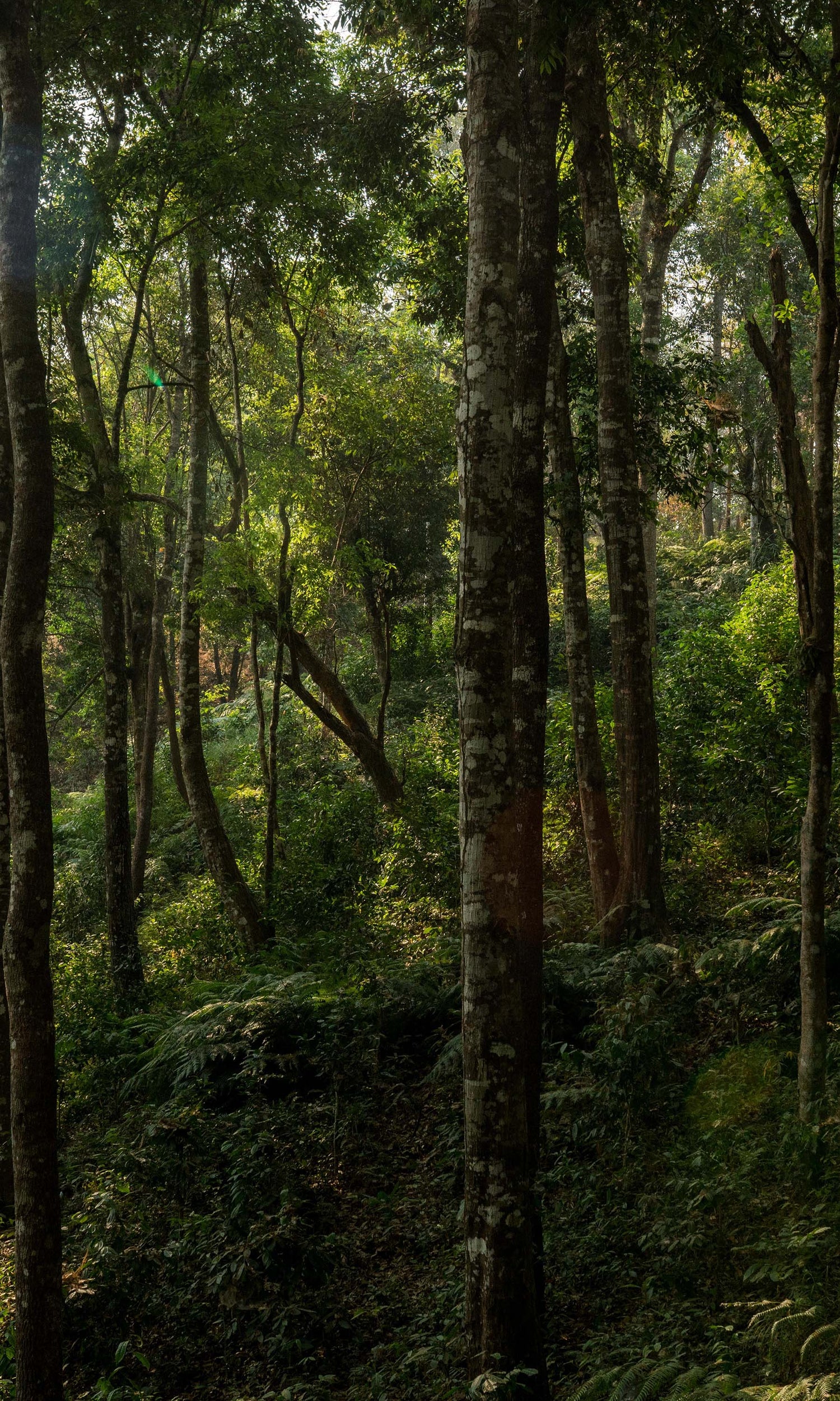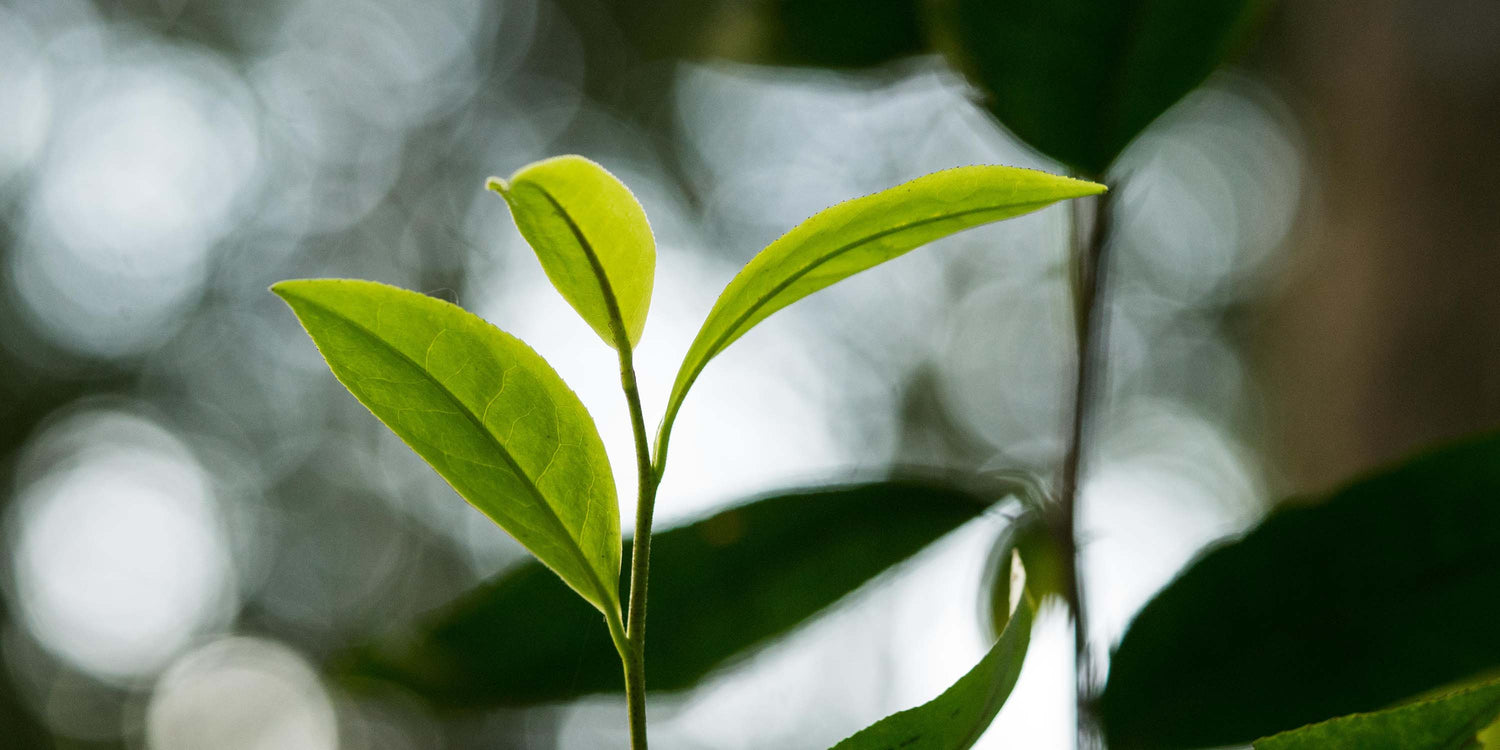LEARN MORE ABOUT TEA

Where does tea come from?
The tea plant originally comes from the area surrounding the "Himalayan Tail", a lower mountain chain spanning from Assam in India to Yunnan in China, passing through Myanmar, Thailand and Laos. In these areas there still exist completely wild tea plants growing in the jungle, never touched by human hands. From there the plant spread around the world, most notably to Sri Lanka, Taiwan and Kenya, where a lot of tea is produced today.
What is oolong tea?
Oolong tea can best be described as an in-between of green and black tea as it is semi-oxidized. After the leaves are harvested, they are left to dry for a moment in the sun to then be rolled or kneaded into the characteristic shape oolong tea has. This results in oxygen reaching different parts of the leaves to different degrees and they’re oxidized unevenly. Before the leaves are allowed to fully oxidize they are heated to stop the oxidization process, and the oolong tea now has unique traits from both green and black teas.
Easily put, oolong tea is more full-bodied and rounder than green teas but at the same time smoother and lighter than black teas.
Oolong teas can be brewed multiple times and flavors and colors will change after every brew. You can extend the brew time after each time to get a stronger tea and better result. Experiment!
What is black tea?
Black tea is a type of tea that is made from the leaves of the tea plant (Camellia sinensis). It is called "black" tea because of the color of the tea leaves after they have been fully fermented. Black tea is the most oxidized of all types of tea, which means that the leaves are allowed to fully oxidize or ferment before they are dried and processed. This gives black tea its distinctive flavor and color, which is generally stronger and darker than other types of tea.
What is green tea?
Green tea is lighter and smoother than other teas, often with a more grassy taste tone. It’s the type that is most consumed in Asia whereas Europeans more commonly drink black tea. Our green tea is produced in harmony with nature, growing inside of forests in Northern Thailand and acting as a guardian for the many organisms living together with it.
Green tea is not oxidized during production, to avoid the oxidization process, the tea leaves are heated either through roasting or steaming after they’ve been harvested. The heat destroys the enzymes that otherwise would react to oxygen in the air and oxidize the leaves. Green tea contains caffein, as does any tea from the tea plant, Camelia Sinensis, but it does contain a slightly less amount than black teas. We have some fantastic green teas, both pure and flavored, but if you’re looking for something extra special, give our Dhara Artisanal Green a try! Handpicked and handmade in small batches, this pure green tea will leave you dreaming about the next cup.
What is white tea?
White tea is a type of tea that is made from the young leaves and buds of the tea plant (Camellia sinensis). It is called "white" tea because the leaves and buds are covered in fine white hairs, which gives the tea its distinctive appearance. White tea is minimally processed, which means that it is generally harvested when the leaves are young and then allowed to wither and dry naturally, without being rolled or otherwise manipulated. This results in a tea that is delicate and subtle in flavor, with a pale yellow or light green color.
How is tea made?
First of all, all teas, whether they're green, black, white, oolong or Pu-ehr are made from the leaves of the same plant, the tea plant "Camelia sinensis". After the buds and top leaves are picked from the tea plant, the production process begins. This is where tea masters add their own touch and create the different types of tea.
White teas are the least processed of all teas, but not the easiest to get right because of that! Young leaves are dried in the sun and then in the shadow. The amount of time spent outside, temperature, rounds between sun and shade are all factors that play part in the final product.
Black teas are picked, dried and crushed. The crushing process starts a fermentation process in the leaves that darkens them before drying and shaping.
What is Hmiang?
Hmiang is a traditional Northern Thai dish made of fermented tea leaves and it is actually strongly connected to the origins of tea. Before we humans learned to use the tea plant to create a brew we ate the leaves. By picking large leaves from the entire tea plant, putting them together in a bundle and fermenting them, people in the mountains along the Himalayan tail enjoyed tea for millenia. The tradition to make hmiang has been on a steady decline for the last century, but can still be found in places in Northern Thailand.
What is the difference between Forest Friendly and organic tea?
While going organic is a great step forward, we still see a huge issue with many of the organic tea plantations over the world in that they are what they are, plantations. The vast majority of organic tea plantations are monocrops with no real regard for surrounding nature or biodiversity. Forest Friendly tea goes beyond organic, encompassing all the principles of organic agriculture but also emphasizing the importance of forests and biodiversity.
How do you flavour tea?
Tea gets a lot of flavor just from the process when it's being produced. When you pick the leaves of the tea plant, there are countless different ways to bring about different flavors and notes in the tea as you produce it. But generally, all flavored teas also have added flavor to them in one way or another. Teas flavored with spices or herbs usually contain those dried spices or herbs and this brings out a lot of flavor. Fruitier teas however need to be flavored with oils to create the taste tea producers are looking for. All of our flavored Forest Friendly Teas are flavored with completely food-safe essentail oils at our flavoring factory in Thailand.
What is the difference between loose leaf and tea bags?
Loose leaf teais what you will find in most of our products, and to brew loose leaf tea you will need some form of strainer when you make your tea. The tea leaves are often much bigger than the tea you will find in your standard tea bag, as it hasn't been crushed and made into a finer powder through machines. Whether it taste better or not is up to the drinker to decide, but we at Monteaco like drinking loose leaf teas more than tea bags for the better retained flavor and quality of the tea leaves.
How should i recycle my Monteaco tin cans?
Click here to learn more about how we recommend you to refill, reuse, and recycle your Monteaco tin cans.
If you have a lot of tin cans from our tea piling up at home, there are a number of things you can do with them instead of just throwing them away in the trash.
Our recommended suggestion is that you upcycle them and turn these tins that once held delicious tea into something else! Around our office we’ve used the tins for all kinds of purposes over the years. Pencil holders, piggy banks, tip jars, or even as pots to grow plants in. The only thing holding you back is your imagination.
Our other suggestion is that you recycle them. You can either take them to a local recycling center or see if your municipality has a recycling program for tin cans. We do not encourage anyone to throw our tins straight in their household trashcan as there are much better ways to get rid of them.
Together we can play a part in creating a more sustainable future, so while we do our absolute best to provide you with some of the most sustainably produced teas in the world without impacting nature or biodiversity, we hope you join us and play a part in lowering the impact of the products we’ve supplied you with.
What is a forest?
A forest is an area of land that is covered with trees and other vegetation. Forests can be found in many different parts of the world and can vary in size, type, and composition. Forests are home to a wide variety of plant and animal life, and they play a vital role in the environment by providing a habitat for many species, helping to regulate climate, and protecting the soil.
Forests can be classified in a number of ways, including by the type of trees that dominate the area, the climate in which they grow, and the elevation at which they are found. Some common types of forests include tropical rainforests, temperate deciduous forests, and coniferous forests. Forests can also be categorized based on their level of human intervention, with terms such as "old growth," "secondary," and "plantation" forests used to describe different stages of forest development.

